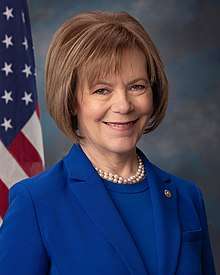Minnesota Democratic–Farmer–Labor Party
The Minnesota Democratic–Farmer–Labor Party (DFL) is a political party in the U.S. state of Minnesota. It is affiliated with the U.S. Democratic Party. Formed by a merger of the Minnesota Democratic Party and the Minnesota Farmer–Labor Party in 1944, the DFL is one of only two state Democratic Party affiliates of a different name (the other being the North Dakota Democratic–Nonpartisan League Party).
Minnesota Democratic–Farmer–Labor Party | |
|---|---|
 | |
| Abbreviation | DFL |
| Chairperson | Ken Martin |
| Governor of Minnesota | Tim Walz |
| Lieutenant Governor of Minnesota | Peggy Flanagan |
| Senate Minority Leader | Susan Kent |
| House Speaker | Melissa Hortman |
| Founded | April 15, 1944 |
| Merger of | Minnesota Democratic Party and Minnesota Farmer–Labor Party |
| Headquarters | 255 Plato Boulevard East Saint Paul, Minnesota |
| Youth wing | Minnesota Young DFL (MYDFL) |
| Ideology | Modern liberalism Social liberalism |
| National affiliation | Democratic Party |
| Colors | Blue |
| Senate | 32 / 67 |
| House of Representatives | 75 / 134 |
| Statewide Executive Offices | 5 / 5 |
| U.S. Senate | 2 / 2 |
| U.S. House of Representatives | 5 / 8 |
| Website | |
| www | |
History
The DFL was created on April 15, 1944, with the merger of the Minnesota Democratic Party and the larger Farmer–Labor Party. Leading the merger effort were Elmer Kelm, the head of the Minnesota Democratic Party and the founding chairman of the DFL; Elmer Benson, effectively the head of the Farmer–Labor Party by virtue of his leadership of its dominant left-wing faction; and rising star Hubert H. Humphrey, who chaired the Fusion Committee that accomplished the union and then went on to chair its first state convention.
By the party's second convention in 1946, tensions had re-emerged between members of the two former parties. While the majority of delegates supported left-wing policies, Humphrey managed to install a more conservative ally, Orville Freeman, as party secretary. Some Farmer–Labor leaders such as Benson moved to the Progressive Party.[1]
Freeman was elected the state's first DFL governor in 1954. Important members of the party have included Humphrey and Walter Mondale, who each went on to be United States senators, vice presidents of the United States, and unsuccessful Democratic nominees for president; Eugene McCarthy, a U.S. senator who ran for the Democratic presidential nomination in 1968 as an anti-Vietnam War candidate; and Paul Wellstone, a U.S. senator from 1991 to 2002 who became an icon of populist progressivism.[2]
Current elected officials
Members of Congress
U.S. Senate


Democrats have held both of Minnesota's seats in the U.S. Senate since:
- Class 1: Amy Klobuchar (since 2006)
- Class 2: Tina Smith (since 2018)
U.S. House of Representatives
Out of the eight seats Minnesota is apportioned in the U.S. House of Representatives, five are held by Democrats:
Statewide officials
Democrats control all five of the elected statewide offices:
State legislative leaders
Current leadership
- Chair: Ken Martin (since 2011)
- Vice Chair: Marge Hoffa (since 2011)
- Treasurer: Tyler Moroles (since 2017)
- Secretary: Adi Penugonda (since 2019)
- Outreach Officer: Shivanthi Sathanandan (since 2015)
See also
References
- Nathanson, Iric (February 26, 2016). "The caucus that changed history: 1948's battle for control of the DFL". Minnesota Post.
- Loughlin, Sean (October 25, 2002). "Wellstone Made Mark as a Liberal Champion". CNN. Retrieved June 23, 2014.
Further reading
- Delton, Jennifer A. Making Minnesota Liberal: Civil Rights and the Transformation of the Democratic Party. Minneapolis: University of Minnesota Press, 2002.
- Haynes, John Earl. "Farm Coops and the Election of Hubert Humphrey to the Senate". Agricultural History 57, no. 2 (Fall 1983).
- Haynes, John Earl. Dubious Alliance: The Making of Minnesota's DFL Party. Minneapolis: University of Minnesota Press, 1984.
- Henrickson, Gary P. Minnesota in the "McCarthy" Period: 1946–1954. Ph.D. diss. University of Minnesota, 1981.
- Lebedoff, David. The 21st Ballot: A Political Party Struggle in Minnesota. Minneapolis: University of Minnesota Press, 1969.
- Lebedoff, David. Ward Number Six. New York: Scribner, 1972. Discusses the entry of radicals into the DFL party in 1968.
- Mitau, G. Theodore (Spring 1955). "The Democratic–Farmer–Labor Party Schism of 1948" (PDF). Minnesota History. 34 (5): 187–194. JSTOR 20175887.
External links
| Wikimedia Commons has media related to Minnesota Democratic-Farmer-Labor Party. |